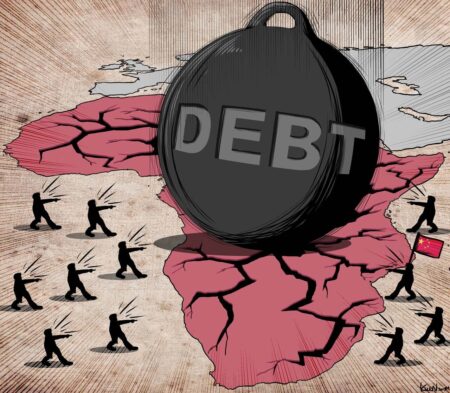- In Kenya, political protests accelerated the downturn, leading to a sharp dip in output that was the fastest since August last year.
- Forex woes and reports of rising fuel prices and taxes equally pushed up business costs in July.
- In Uganda, data shows output and new orders are edging up steadily on a monthly basis in the past one year.
Kenya’s private sector activity suffered a further drop in demand at the start of the third quarter of the year, latest statistics show, as customers continued to limit spending amid steep inflation. Kenya’s poor data came even as neighbouring Uganda recorded improvements in the health of the its private sector activity. Uganda is experiencing a stronger demand environment despite facing challenges in the macro environment.
In Kenya, political protests accelerated the downturn, according to surveyed firms. This resulted in a sharp contraction in output that was the fastest since August last year.
Meanwhile, deterioration in the exchange rate and reports of rising fuel prices and taxes culminated in another substantial rise in business costs in July. According to statistics, the rate of input price inflation post the quickest since the survey began in 2014.
Output prices subsequently increased to a sharper degree as business optimism waned slightly, while jobs growth eased.
Read also: Kenya seeks private sector backing for oil dream
Purchasing Managers’ Index
The headline figure derived from the survey is the Purchasing Managers’ Index (PMI). Readings above 50 signal an improvement in business conditions on the previous month, while figures 50 depict a deterioration.
The latest reading indicated a greater slump in operating conditions over July. Start of the second quarter shows the pace of deterioration accelerating fastest in almost a year. At 45.5, the index was down from 47.8 in June, registering below the 50 mark for the sixth month in a row.
“July’s PMI headline trajectory comes as no surprise given events during the past month. Political protests, an increase in pump prices, the further tightening of financial conditions as well as a further depreciation of the shilling—all of which saw the private sector deteriorating for a sixth straight month,” explained Christopher Legilisho, Economist at Standard Bank.
Notably, the survey results show that the July contraction in output was the deepest since August 2022.
Fall in new business inflows
Deteriorating operating conditions were driven by a sharp fall in new business inflows. In the period, Kenyan firms highlighted a drop in client demand due to the cost of living crisis. Alongside this, several firms noted that political demonstrations adversely affected sales.
Four of the five monitored sectors recorded a decline in sales in July. Agriculture was the only category to post inside growth territory. With overall sales falling rapidly, Kenyan businesses indicated a sharp drop in output over the course of July. Notably, this was the second-worst since 2017, excluding Covid-19 lockdown periods.
Firms often noted that weak orders resulted in cash flow issues that limited activity. Price pressures at Kenyan companies remained severe in July, amid reports of a sharp rise in input costs due to a decline in the shilling exchange rate.
Higher fuel prices and increased tax burdens were also cited, while some firms increased workers’ pay to tackle cost-of-living crisis.
Notably, the rise in overall input costs was one of the sharpest seen since data collection began in 2014. Higher input costs saw companies register faster rise in selling charges.
“Inflation seems set to stay stickily high due to Kenyan businesses facing intractable input, output and wage price pressures. The survey noted input price inflation in July as being higher than in June, and also the third highest since data collection began in 2014,” Legilisho said.
Weak demand
Heightened costs and weak demand contributed to a cooling of employment growth in July. Only a small number of firms reported slight rise in workforce numbers.
Concurrently, businesses cut their input purchases sharply, ending a four-month run of inventory growth as stock levels remained flat. Further, the Lead times on inputs continued to shorten, but the rate of improvement slowed from June.
Regarding future output, only 14 per cent of surveyed Kenyan firms forecast growth over the next 12 months. This has the overall effect of leading to a slight weakening in the overall level of confidence.
Nevertheless, some positive indications spell economic resilience in the medium term. The agricultural sector rebounding has been supporting Kenya’s economic recovery. This is despite the construction, wholesale and retail and services sectors slowing.
“Export orders remain in expansionary territory, buoyed by the weaker shilling. However, new export order growth slowed considerably. Though employment in the private sector is still robust, momentum there too has cooled, ” Legilisho said.
Read Also: Why Kenya’s business confidence has hit record low
Uganda
In Uganda, July saw ongoing improvements in the health of the country’s private sector, driven by a stronger demand environment. Both output and new orders edged up on a monthly basis throughout the past year.
Equally, firms increased their employment and purchasing activity in response to greater workloads. “Activity in Uganda’s private sector expanded again in July, albeit slower than in June. Notably, output was robust economy-wide, with new export orders posting growth for the first time in seven months,” Legilisho said.
Furthermore, employment levels increased for a fourth month due to brisk demand. New orders were attributed to higher customer numbers, client recommendations, good quality products, and marketing.
Meanwhile, input costs continued to purchasing activity at the start of the third quarter. Employment was up for the fourth month running, while input buying has now increased in nine successive months. A further accumulation of inventories is expected.
Greater operating capacity meant that firms were able to keep on top of workloads, and reduced their backlogs of work again in July.
Increases in purchase prices
Latest data shows ongoing increases in both purchase prices and staff costs. Those respondents that saw purchase costs rise mentioned building materials, food products and land in particular as being up in price.
“Across the five monitored sectors, on the pricing front price pressures were apparent in building materials, electricity, and fuel in particular, as well as in purchase costs and staff costs. However, output prices in agriculture were down,” said Legilisho.
Meanwhile, employee pay was often raised in response to higher living costs. Output prices also increased as companies passed on higher input costs to their customers. Agriculture was the only sector to buck the wider trend and post a reduction in charges, according to the survey.
Further improvement
Demand conditions are expected to improve further over the year ahead, helping lead to increases in customer numbers and further output growth.
According to the survey, approximately 89 per cent of panelists predicted an expansion of business activity over the coming 12 months. This is despite increase in purchase prices and staff costs which could see firms raise their own selling prices.
The headline PMI remained above the 50.0 no-change mark in July, signaling a further strengthening in the health of the Ugandan private sector. The latest reading of 53.9 was above the series average (52.6), despite coming in below June’s figure of 56.4.
A further rise in new orders in July meant that the current sequence of monthly expansion extended to a full year.
Respondents cited a number of factors as having driven growth in the latest survey period, including rising customer numbers, recommendations from clients, good quality products and successful marketing.
Stronger demand
The stronger demand environment also helped business activity to increase for the twelfth month in a row. Output rose across the agriculture, construction, industry, services and wholesale and retail categories.
Of the surveyed managers, companies looked to expand capacity in response to higher new orders, raising both their employment and purchasing activity at the start of the third quarter.
“Ugandan businesses are bullish about economic conditions 12 months from here,” the survey noted.
The Stanbic Bank PMI is compiled by S&P Global from responses to questionnaires sent to purchasing managers in a panel of around 400 private sector companies. The panel is stratified by detailed sector and company workforce size, based on contributions to GDP. The sectors covered by the survey include agriculture, mining, manufacturing, construction, wholesale, retail and services.











